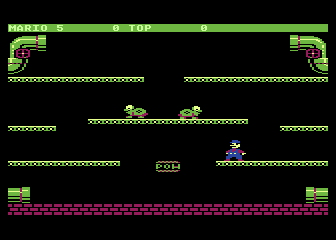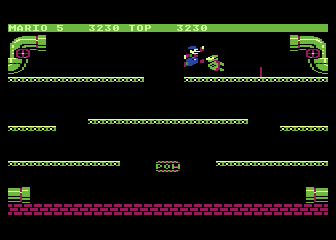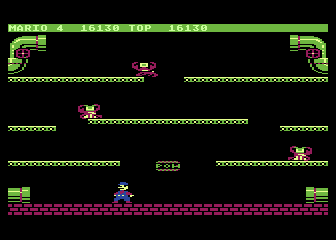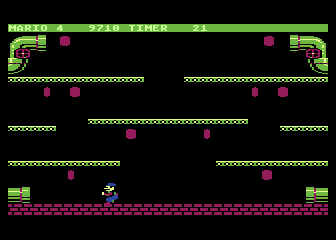|
|
Mario Bros.
|
Name:
|
Mario Bros. |
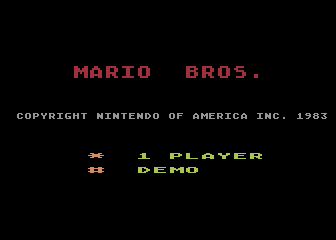 |
| Company: | Atari | |
|
Model #:
|
CX-5247 | |
|
Programmer:
|
Bob Merrell | |
| Year: | 1983 | |
|
Released?
|
Yes
|
|
|
Notes:
|
Mario Bros. was the first game to feature Luigi. |
Long before their adventures in the Mushroom Kingdom, Mario and his brother Luigi were just a couple of simple carpenters trying to make an honest living. However things didn't quite go as planned... From out the water pipes came deadly Turtles, dangerous Crabs, and worst of all Fireflies (from the sewer?)! Mario must team up with his brother Luigi and rid their house of these deadly pests forever.
Since it would be years before Mario and Luigi would begin experimenting with "Magic Mushrooms", they'll have to tackle these pests as plain old "non fireball slinging" carpenters. Your only weapon are your fists, which you use to smack the floor. When you hit the floor directly beneath your enemies, they will be flipped over and become easy prey for you to kick off the screen. However if things were really this easy you wouldn't need a buddy to help now would you?
There are three different types of enemies Mario and Luigi will encounter Shellcreepers, Sidesteppers, and Fighterflys. Each creature requires a special strategy to defeat as they each have different personality and method of attack.
| Shellcreepers |
|
These slow moving turtles and are first enemies
you will encounter. Shellcreepers only require one hit to
flip over. Punch 'em, flip 'em, kick 'em, and move on.
|
| Sidesteppers |
 |
These mean looking crabs are encountered after
a few levels. Not only are Sidesteppers much faster than Shellcreepers,
but they require two hits to flip over. After the first hit
the Sidestepper will turn red and greatly increase in speed. It's
best to hit them twice in quick succession or they'll get away from
you.
|
| Fighterflys |
|
Fighterflys are the third and final nasty that
you'll encounter. Fighterflys are unique as they move around
the screen by jumping instead of crawling. When a Fighterfly
is in the air it cannot be hit, so you must carefully time your
jump so you hit the platform when the Fighterfly is on the ground.
Thankfully Fighterflys only require one hit to flip.
|
If things start getting out of hand you can hit the POW bar at the bottom of the screen. Hitting the POW bar is like hitting every floor segment at once, and will hit all the enemies (assuming they're touching a floor segment). You only get a limited amount of POW, use it wisely! After a few levels fireballs will begin to randomly appear and cross the screen, so unless you want to be burnt to a crisp avoid them! There are two different kinds of fireballs in the game: Gold fireballs will stay on the level they appear, but orange fireballs will bounce around to different levels (which makes them especially dangerous). On later levels a nasty little monster called "SlipIce" appears and will freeze floor segments making you slip out of control. Try and knock off this little blighter as soon as possible.
Every time you successfully knock off an enemy a coin will come out of one of the pipes which you can grab for points. After a few levels you'll get to play a bonus round in which coins are scattered around the screen in various patterns. If you can collect all the coins before the timer reaches zero, you can score mega bonus points. However some bonus rounds have invisible levels which make them especially tricky.
Mario Bros. was one of the first arcade games to allow for two player simultaneous play, and is one of the few 5200 games with such a feature. While Mario Bros. isn't a bad game for one player, it's when it's played with a friend that the game really shines. Mario Bros. was programmed for the Atari 400/800, but not released until 1987 when an updated version appeared on the Atari XE. So if you want to see what the Mario Brothers were doing before that whole Mushroom Kingdom thing, give Mario Bros. a try. You'll be glad you did.
| Version | Cart Text | Description |
| ?/??/83 | None | Early movement demo |
| 9/14/83 | Mario Bros. 9-14 | Very close to final |
| 9/23/83 | Mario Bros. 09-23-83 | Final version |

